CONTENTS
With the increased availability of ‘tap-and-go’ bank cards, credit card fraud has skyrocketed. In Western Australia between July 2017 and June 2018, credit card fraud jumped from a meagre 753 offences to a whopping 2,051 offences – an increase of 1,298 offences. According to Western Australian Police Commissioner Chris Dawson, “Thieves are breaking into houses, homes and stealing credit cards from people and are able to very quickly fraudulently obtain property by simply going under $100 in every purchase (ABC.net)” .

Banks, however, are becoming more and more aware of the possible risks of contactless payment. Phone applications allow for constant monitoring of bank accounts so that withdrawals and deposits can be verified, banks themselves send out monthly virtual and/or paper statements and call card-owners if unusual activity is detected, and banks also allow for easy locking and/or closure of accounts if a card is lost or stolen. These preventative measures haven’t always been available.
On the 19th of May 2000, a Bank of East Asia debit card was stolen from a Hong Kong exchange student in Brisbane. The student’s father reported the card stolen to the Bank of East Asia within the week but the bank hadn’t taken much notice of the report, leaving the student’s accounts open. Little did they know, this card was about to be linked to one of Australia’s largest ever credit card frauds along with one of the nation’s longest running mysteries: the disappearance and suspected murder of Vietnamese-Australian man Quyen Tu Au.
Who Is Quyen Tu Au?
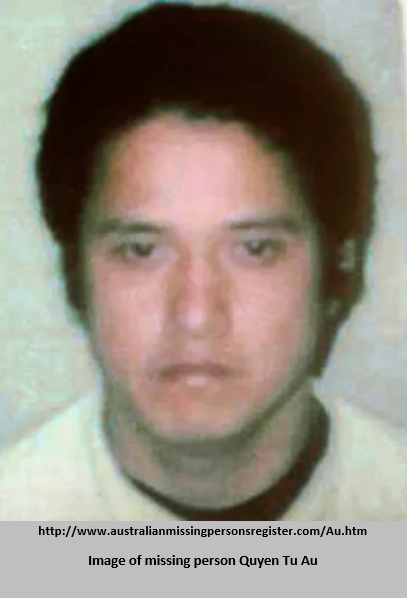
Quyen Tu Au was born in Vietnam in 1971 and had moved to South Australia in 1985 when he was only 14 years-of-age. The reason for this move has never been reported – along with a large majority of Quyen’s life – but it is known that his older brother Tu Tai Au, or ‘Troy’, had moved also at some point, as he had been living in the Adelaide district around the time of Quyen’s disappearance.
In the year 2000 Quyen had been living in a home in Rosewater Lodge, Rosewater. This particular lodge has since been remodelled into an assisted living age-care facility and renamed ‘The Oaks at Rosewater’, but, it was likely an inexpensive living quarters for those who were suffering from mental health problems. Whether Quyen had a mental illness or not has never been reported and due to this, it is safe to assume these issues – existent or not – were not directly linked to Quyen’s disappearance.
The Lodge itself didn’t exactly have the best reputation at the time either. In 2001, a mental health worker had found the body of a newborn baby in the courtyard of the Rosewater Lodge. It was recovered from a wheelie bin and had been placed in a plastic bag. The mental health worker and emergency workers had attempted to revive the baby, but unfortunately it was too late. The mother was never charged due to mental health issues.

Quyen was not reported to have had any close friends at the time, but he was reported to have had a group of acquaintances he spent a fair amount of time with. These four acquaintances were An Man Tran, Tran’s wife Thanh Hua, Tran’s brother An Thanh Tran, and Thanh Hua’s brother (An Man Tran’s brother-in-law) Mau Ung Hua. An Man Tran and his wife, as well as possibly his brother and brother-in-law, shared a property in Kitchener Street, Kilburn, in South Australia. The exact nature of the relationship between these four and Quyen Au prior to his disappearance has not been reported and is still under investigation.
Quyen Tu Au and the ATM Fraud
On the 19th of May 2000, Quyen Tu Au stole a Bank of East Asia debit card from a Hong Kong exchange student in Brisbane and somehow obtained the bank card’s PIN number. It wasn’t until the 28th of July that same year that Quyen first used that bank card and once he realised he could successfully withdraw money from this account, he continued to do so for a period of 18 days. Attempting to avoid suspicion, Quyen made several small transactions each day at several different ATMs, all ATMs being run by the National Bank of Australia (NAB), and almost all withdrawals consisting of $50 notes.

Although it’s safe to say Quyen knew there was money on this debit card, what he didn’t know was that the Bank of East Asia card activated a glitch in the NAB ATMs that allowed for unlimited withdrawals, regardless of the amount of money in the card’s accounts. Had Quyen chosen any other ATMs to withdraw this money from, the following events may have never happened.
On the 15th of August, Quyen was caught by ATM security cameras withdrawing money from the stolen card. He made 12 transactions on this day, the first at 12:21pm and the last at 12:35pm. He reportedly withdrew $6,000 during that transaction. This type of transaction certainly wasn’t unusual for Quyen. Over the past 18 days he’d made a total of 467 transactions, been caught on ATM CCTV making withdrawals 41 times, and had withdrawn a total of $327,120. This day, however, would be the last day anyone would see Quyen Tu Au alive.

However, although the 15th of August was the last time Quyen was confirmed to have used the stolen debit card, it certainly wasn’t the last time the debit card was used. In fact, following Quyen’s disappearance, the amount of times the card was used and the amount withdrawn skyrocketed.
From what is assumed to be the day of Quyen’s disappearance to the 19th of October, three men and one woman were known to have had access to the stolen debit card Quyen once held. These men were An Man Tran, his wife, his brother and his brother-in-law – the same four linked to the property in Kitchener Street, Kilburn and who were known associates of Quyen. Over the 65 days following Quyen’s disappearance, they had conducted an extra 6,330 transactions and withdrew a whopping $5,999,200.
On the 6th of October 2000, An Man Tran – who had possession of the stolen card at the time – handed the card to his brother An Thanh Tran as he travelled to Vietnam with his wife Thanh Hua. An Thanh Tran continued the daily routine of making transactions on this stolen debit card. That was until one faithful day – October 19th 2000 – when NAB finally discovered the computer glitch that had led to the unlimited withdrawals, an ATM in the Tea Tree Shopping Plaza, Modbury, swallowed the stolen card, and the National Bank of Australia contacted South Australian police.
The Investigation
It didn’t take long for police to kick into high gear. In November 2000, police searched 17 different properties in the Adelaide region for the stolen money and found $4.07 million hidden beneath the floorboards of the main bedroom of a home in Kitchener Street, Kilburn. This same month police issued a warrant for Au’s arrest on ‘conspiracy to steal’. It wasn’t until the 14th of May 2002 – a full 18 months later – when the Major Fraud Section in South Australia, unable to find him, expressed concern for his welfare. In September 2002, his disappearance was declared a Major Crime.
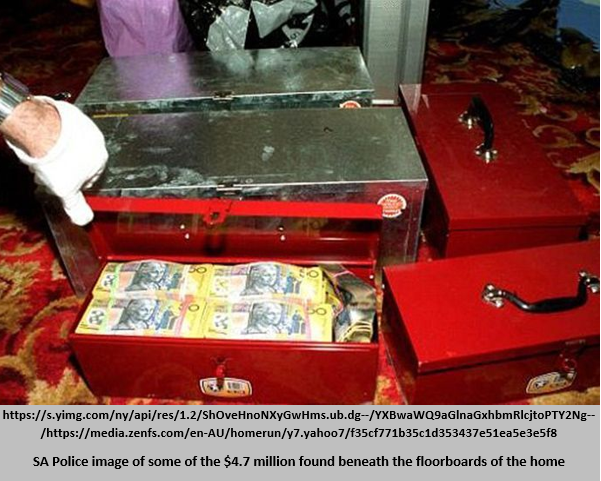
On the 22nd of August 2003, a 33-year-old Wingfield man – likely An Man Tran – was arrested by Major Fraud Unit Section Detectives in his Sixth Street home in relation to the ATM fraud. He was charged on this same day with receiving, unlawful possession, money laundering, making false declarations, and structuring, an offense relating to depositing small amounts of cash into accounts to avoid scrutiny.
In this home, detectives also found 6kg of ammonium nitrate – a chemical used in gunpowder. Detectives didn’t believe this discovery was linked to the ATM fraud or Quyen’s disappearance, but they were still investigating how this man came to be in possession of the chemical.
This Wingfield man wasn’t the only one to get caught and charged for the ATM fraud however. An Man Tran (suspected to be the Wingfield man) received a 6-year jail sentence, An Thanh Tran (An Man Tran’s brother) received a 3-year jail sentence, Thanh Hua (An Man Tran’s wife) served 9-months on remand, and Mau Ung Hua (Thanh Hua’s brother and An Man Tran’s brother-in-law) was arrested, but his charges were dropped. Once Quyen was determined to be a missing person, these four were once again thrown into the spotlight, and for good reason.
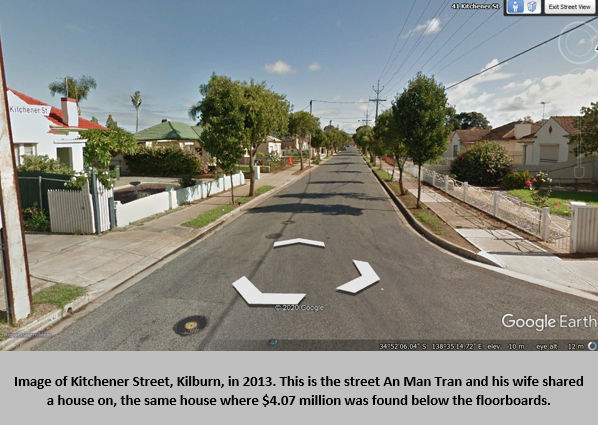
An anonymous source told police that Quyen had been living in the same Kilburn home that the $4.07 million was recovered in. Quyen was determined to have left his Rosewater Lodge home on the 5th of August 2000, confirming that he had been residing elsewhere over the 10 days prior to his disappearance. However, a majority of his belongings, including clothes and a TV, were left behind in the Rosewater property, likely indicating he was planning on returning at some point in the near future. This Kitchener home was the home of An Man Tran and his wife. If Quyen had been staying in this home, it’s likely either Tran or his associates were the last to see Quyen alive.
Quyen was also seen at a car yard in Hilcrest on North East Road on the 14th of August 2000, only one day prior to his disappearance, with a man who had looked like one of the known associates of the ATM fraud. Here he purchased a Mitsubishi Verada, registering it under his name and using $18,000 cash which he likely obtained using the stolen credit card.

This car, however, didn’t stay with Quyen for very long. On the 18th of August, just 3 days post Quyen’s disappearance, the Verada’s registration was transferred – most likely fraudulently – from Quyen to one of Quyen’s known associates. This associate then proceded to trade in the car for a brand new 100 series Landcruiser on the 1st of September, only 14 days after they obtained registration. Police managed to question the man about these events, but the man never provided any explanation as to how or why Quyen transferred the registration, or why he traded in the car so quickly. Perhaps expecting the car to be linked with some form of foul play – such as aiding in moving and/or disposing of Quyen’s body – the Verada and the Landcruiser were forensically tested, but led to no clues as to Quyen’s fate or his whereabouts.
A day later, detectives began to re-investigate the Kilburn property the $4.07 million was found in. An anonymous source hinted to police that Quyen Au’s body may have been buried under this home. This didn’t seem too outlandish a theory, as the homeowners had lain tiles over the floorboards of almost every room in the house shortly after Quyen’s disappearance, reasonably enticing suspicion from those aware of the case. It took 6 hours for forensic services to fully search the home, using probes and industrial equipment to dig up the tiles as well as the backyard. The search was to no avail, however, as the only remains found were bones that were later confirmed to belong to an animal.
Since his disappearance, Quyen Tu Au has never since accessed any of his bank accounts or opened new bank accounts, registered any new vehicles, and there has been no record of Quyen travelling overseas. The South Australian government, in an attempt to garner more leads, has approved of a $200,000 reward for any information that results in the discovery of Quyen’s remains, or the conviction of the person/persons responsible for Quyen’s disappearance.
The Timeline
To fully understand this case, it’s important to establish the timeline of events before, during and after Quyen Tu Au’s disappearance.
Note: This timeline has been constructed using a range of articles, all listed in the ‘Resources’ section of this article. To ensure some measure of validity, at least two articles stating identical relevant information were required, but not all information can be accurately verified. If you believe any of the below timeline to be incorrect or inaccurate, please use the ‘Contact Me’ page to express your concerns.
19th May 2000 – Friday
Quyen stole a debit card from a Hong Kong student in Brisbane, Australia. The father of the exchange student reported the card stolen to The Bank of East Asia shortly after it was taken, but the bank itself took no action at the time.2000 (Exact date unconfirmed)
Quyen’s older brother, Tu Tai Au (also known as ‘Troy’) last saw Quyen at a China Town food court in Adelaide. Quyen said he had just returned from Queensland (likely the same trip in which he’d stolen the Hong Kong student’s debit card).28th July 2000 – Friday
The first transaction was made on the stolen debit card by Quyen Tu Au. This was 70 days following the theft of the card.5th August 2000 – Saturday
Quyen left his Rosewater Lodge home, leaving behind his clothing and other property such as his TV. This was 10 days prior to the last time he was ever seen (15th August 2000) on ATM security cameras.14th August 2000 – Monday
Quyen paid $18,000 in cash for a Mitsubishi Verada, which was purchased from a car yard on North East Road in Hilcrest. Here he was sighted with another man who reportedly matched the description of a known associate of Quyen, who is also a suspect in Quyen’s disappearance.15th August 2000 – Tuesday
This was the last confirmed time Quyen was sighted in person or on tape. He was recorded on CCTV at an NAB ATM in Port Adelaide withdrawing money from the stolen debit card. He made 12 transactions on this day, the last at 12:35pm, and withdrew approximately $6,000 in all.Quyen rang a friend at 12:45pm, though the friend’s name and what was discussed in the call has not been reported.
16th August 2000 – Wednesday
Quyen called his family.18th August 2000 – Friday
The registration of the Mitsubishi Verada was transferred from Quyen to anaccomplice of Quyen. This accomplice was later interviewed by police and did not provide any explanation as to why Quyen transferred his vehicle’s registration to him so soon after its purchase.1st September 2000 – Friday
The Mitsubishi Verada was traded in by the new owner for a new 100 series Landcruiser at a city dealership. The accomplice did not provide an explanation as to why he traded the Mitsubishi Verada in only a month after obtaining registration.6th October 2000 – Friday
An Man Tran, a known associate of Quyen, was in possession of the debit card (suspected to have been in possession of this card from Quyen’s disappearance to this point), though how he became in possession of the card is unknown. He then left this card with his brother, An Thanh Tran, as he went to Vietnam with his wife. An Thanh Tran continued to use this bank card.19th October 2000 – Thursday
The stolen debit card was obtained by the ATM machine at the Tea Tree Shopping Plaza in Modbury, South Australia as the ATM glitch was discovered by the NAB bank. NAB contacted the police in relation to fraudulent activity.November 2000
Police searched 17 properties in Adelaide looking for the stolen cash and perpetrators of the ATM fraud. They found $4.07 million in cash hidden beneath the floorboards of the main bedroom of a Kitchener Street, Kilburn, property.November 2000
Police issue a warrant for Quyen’s arrest for conspiracy to steal.14th May 2002 – Tuesday
Quyen was reported missing by the Major Fraud section of the South Australian police due to concerns for his welfare.September 2002
Quyen Au’s disappearance was declared a Major Crime.22nd August 2003 – Friday
Detectives investigating Quyen’s disappearance froze several bank accounts containing more than $200,000 which were believed to be proceeds of the ATM fraud.27th August 2003 – Wednesday
A Wingfield man was arrested by Major Fraud Investigating Section Detectives in relation to the ATM theft. The 33-year-old and was arrested in his Sixth Street home and was charged with receiving, unlawful possession, money laudering, making false declarations, and structuring, an offence related to depositing small amounts of cash into accounts to avoid scrutiny.Detectives found 6kg of ammonium nitrate – the chemical used in gunpowder – in the Sixth Street home of the arrested Wingfield man. They do not believe this discovery is linked to Quyen’s disappearance or the ATM fraud, but how the man came to be in possession of this chemical was being investigated.
25th – 29th August 2003 – Monday-Friday
A man in the suburbs (likely in South Australia) was interviewed regarding Au’s disappearance and the ATM fraud.28th August 2003 – Thursday
Police searched a Kilburn home (likely the same one the $4.07 million was hidden in) using probes and industrial equipment after a source suggested Quyen’s body may have been buried there. They dug up the backyard and pulled up the tiles, which had been lain over the original floorboards in almost every room in the house shortly after Quyen’s disappearance. Forensics searched for 6 hours and did not find Quyen’s remains. Bones were found but were confirmed to have belonged to an animal.30th August 2003 – Saturday
A man in Queensland was interviewed regarding Quyen’s disappearance and the ATM fraud.Date Unknown
The South Australian government approved a $200,000 reward for any information that led to the recovery of Quyen Au’s remains or the conviction of the person or persons involved in Quyen’s disappearance and suspected homicide.
The Theories
Although the reason for why Quyen Tu Au disappeared that August in 2000 is still unknown, it’s safe to say that Quyen was very likely a victim of a homicide. Detectives, however, haven’t always thought this way.
The Runaway Theory
When police first began investigating the ATM fraud, they had reason to believe Quyen had simply been an adult runaway. Quyen was a known associate of the four who were later arrested and around $1.8 million of the stolen money was missing. Some of Quyen’s property had been taken by Quyen and Quyen himself appeared to have completely vanished into thin air. When asked about the missing $1.8 million, Detective Sergeant Shaun Osborn stated; “they (those involved in the ATM fraud) could have taken a suitcase load to Vietnam (The Advertiser, Adelaide)“. It was certainly plausible that Quyen could have taken this cash, likely escaping overseas to start a new life and avoid punishment for his crimes.

However, there are several pieces of information that appear to discount this theory. Most of Quyen’s belongings were left behind (belongings such as clothing that he would likely have taken with him had he escaped overseas), his name – along with other names he was known to use (using several more ‘western’ names is a common practice among Vietnamese-Australians to avoid confusion or mispronunciation) was never recorded in any overseas travel databases nor were they used to register any vehicles, and his bank accounts have never since been accessed.
He had purchased a new car the day prior to his disappearance and registered it under his name – strange considering he was planning on abandoning it the next day. A detective investigating Quyen’s disappearance, Detective Sergeant Phil Giles, stated “it seems odd that someone planning their own disappearance would go to the bother of buying a new car just to sell it a few days later (The Advertiser, Adelaide)”. Quyen had also left the stolen debit card with his acquaintance An Man Tran, a card which he alternatively could have used to fund his new life overseas, seeming as $327,120 was unlikely to keep him afloat for the rest of his life. Considering he went to so much effort to withdraw these funds, dedicating almost his entire 18 day spree to it – it would have been unlikely for him to simply drop it altogether at the relatively small amount he’d already gathered.
In an interview with The Advertiser on the 27th of December 2008, investigators officially disregarded this theory, stating; “At the beginning, the disappearance was consistent with someone disappearing with a large amount of money, but we are more than satisfied that he has been murdered”.
The Hostage Theory
Quyen had spent 10 days prior to his disappearance at the home of the people most likely to have ended his life, leaving a majority of his belonging in his Rosewater Lodge home. This begs the question: why would Quyen leave his Rosewater home to live with An Man Tran in Kilburn in the first place? Quyen had a large store of cash somewhere – likely somewhere in his house – and so it would have been unlikely he’d decide to leave it alone while he wasn’t there to guard it. However, it also would have been unlikely for Quyen to take that cash with him into the home of somebody like An Man Tran, who was described as an associate rather than a close friend in all forms of media. Knowing the effort Quyen had gone to in withdrawing this money, why would Quyen have trusted Tran enough to hide the money in his home or to leave the money in a bag or suitcase where Tran and his accomplices would have been able to easily find it?
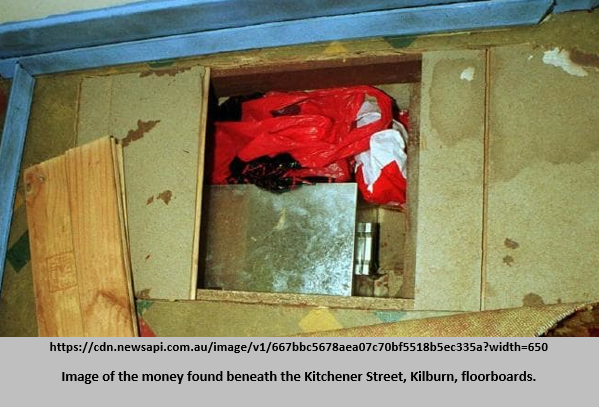
This is where the next theory comes in: that perhaps Quyen had been forcibly taken from his place of residence on the 5th of August to stay with Tran and his associates and withdraw cash for them. Perhaps Tran had eventually gotten the card and pin number off Quyen, killed him and disposed of his body as they realised they no longer had a need for him anymore and that Quyen could very easily report them to police had they kept him alive. This would explain the call that Quyen had supposedly made to his family on the 16th of August, as it was placed after Quyen had stopped making transactions, perhaps to keep up the appearance he was still alive. However, fairly few resources referred to this call – bringing into question this information’s reliability – and the context of the call has never been disclosed.
There are other events surrounding Quyen’s disappearance that appear to rule out this theory. Quyen was not acting any differently and did not appear distressed on ATM CCTV footage when compared to footage prior to August the 5th. He appeared to withdraw the same amounts as he usually did and considering the increased amounts Tran and his associates withdrew post Quyen’s disappearance, it’s Tran would have forced Quyen to withdraw larger amounts.
Quyen was also seen on CCTV purchasing a car with $18,000 dollars cash and registering it under his own name. Had Tran been behind this purchase, Tran likely would have purchased the car himself using Quyen’s cash, or simply forced Quyen to put the registration under his own/another accomplice’s name rather than transferring it days later. With the car being traded in for a Landcruiser less than a month later, it also wouldn’t make sense for Tran to purchase the Verada when he could simply have forced Tran to purchase a car he actually planned on keeping, unless the Verada was specifically planned to be used for the disposal of Quyen’s body (again bringing into question why the registration transfer was undertaken and the paperwork forged, when they could have simply kept it under Quyen’s name and fraudulently sold the car as Quyen, leaving no visible link back to them).
If Quyen did happen to be held hostage for a short period of time, it is almost certain that Quyen would have suffered foul play by these perpetrators on or shortly after the 15th of August 2000.
The Murder Theory
Quyen Tu Au’s disappearance was likely regarded a potential homicide as early as the 14th of May 2002, when the Major Fraud Section of the South Australian police reported him missing due to concerns for his welfare. Quyen had still not been found, his Rosewater Lodge home had not been lived in since August 15, he had not registered any other vehicle under his name, his bank accounts had not been touched and none of family or friends had heard from him since August 16th 2000, raising major red flags for all who knew Quyen. This also brought forth the biggest and most plausible theory in this case: that An Man Tran, Thanh Hua, An Thanh Tran and Mau Ung Hua conspired to murder Quyen and disposed of his body in order to obtain the stolen debit card.

There is a good deal of circumstantial evidence that would point to this theory. The registration of Quyen’s car was transferred to one of Quyen’s associates shortly after the car’s purchase (and following Quyen’s believed date of disappearance, which would suggest this transfer was undertaken fraudulently, likely using a friend posing as Quyen and forging his signature on documents), and the car was also traded in several days later for a new Landcruiser, suggesting that the car either simply wasn’t wanted nor needed by the person who it was transferred to – eliminating any real purpose for Quyen to transfer it to this person in the first place – or suggesting the car was linked to some form of illegal activity and the associate the car was registered wanted to quickly dispose of the car.
Police also found it unlikely that Quyen would have handed the stolen card over to An Man Tran. Instead, South Australian Detective Inspector Greg Hutchins stated investigators “Suspect[ed] that people may have seen him with the card and the cash and worked out what was going on” and that Quyen “was relieved of the card, perhaps after refusing to hand it over or cooperate with them.” (Yahoo News).
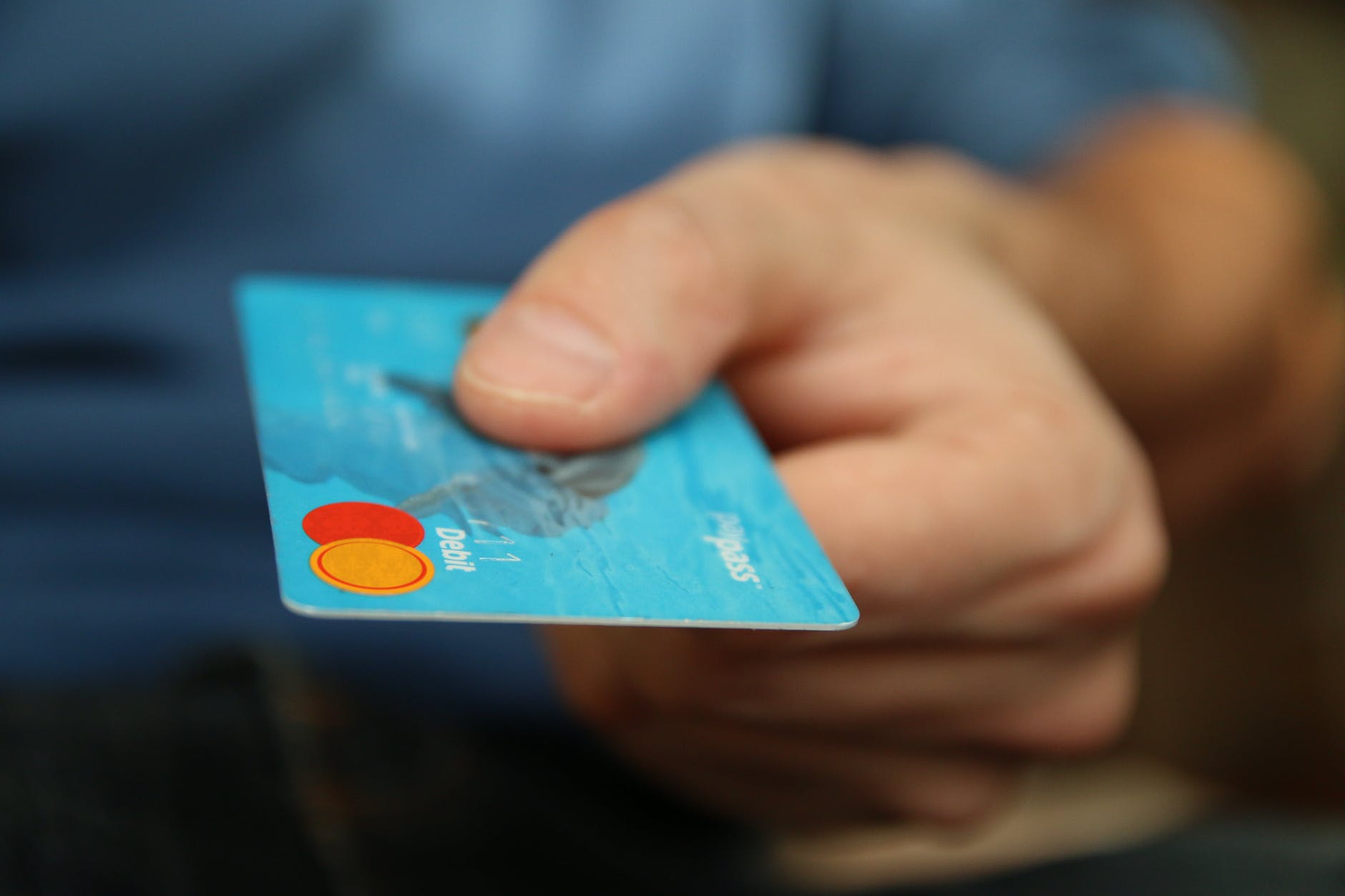
The associates certainly had the motive to dispose of Quyen. Quyen was believed to be living with these four at the time and considering how often Quyen would make withdrawals throughout the day, it was likely that these associates would have taken notice. Quyen had been spotted via CCTV purchasing the Mitsubishi Verada with a person suspected to be one of these associates and had purchased the vehicle using $18,000 in cash, an amount which would likely raise questions with this associate. If they had worked out what Quyen was up to and the amount of money he’d been withdrawing, they may have murdered Quyen to obtain the money and stolen card themselves, hence how they managed obtained the card and withdraw so much money.
If these associates had been responsible for the murder of Quyen, it’s likely Quyen would have suffered foul play on the 15th or 16th of August. Quyen was making regular withdrawals from the stolen bank cards up until this period – never slowing down – meaning the lack of CCTV footage or ATM activity following this period would have been highly unusual and highly unlikely if Quyen were still alive and well.
This then raises the question that detectives have been asking themselves for decades: how did An Man Tran, An Thanh Tran, Mau Ung Hua and Thanh Hua murder Quyen Tu Au, and what happened to his body?
In August 2003, police began another search of the Kitchener Street house, “Working on the possibility that (Mr AU) may have been murdered and may have been in that house” (Superintendent Mick Symons to The Sunday Mail). Tiles had been placed over the floorboards in almost every room in the home, leading to an anonymous report that the body of Quyen had been buried beneath the house and the tiles lain out to hide the evidence. No such evidence was found, but interest in this piece of information still lingers. Had Quyen been murdered in this house, would evidence – such as blood traces or soil disturbance – still have lingered and been detectable to forensics teams? Is it possible Quyen’s body could have been buried beneath these floorboards and tiles, and then moved for reburial at a later date? Police haven’t released the exact date they believed the tiles were placed over the floorboards of the Kilburn home, all we know is there was enough of a correlation between this event and Quyen’s disappearance to cause adequate suspicion. In the end, the only people to truly understand the seriousness of these events in relation to Quyen are the four suspects themselves, and the detectives on their tails.
Conclusion

With all the mystery and intrigue surrounding this case, it’s easy to forget the real heartbreak the family and friends of Quyen Tu Au are facing, and have faced for the past 20 years. Not only are they faced with the possibility that Quyen was murdered in the name of greed, but the complete lack of physical evidence of what did occur has no doubt left them frustrated and confused. In an article with The Sunday Mail, Quyen’s brother Tu Tai Au (also known as ‘Troy’), says he and his family are “hoping the police might find him if he is still alive, or dead already“.
Quyen Tu Au’s disappearance is long overdue to be solved, and police are desperate for answers. Detective Inspector Greg Hutchins told ABC.net: “We believe this case is solvable – we only need one final piece of information from the right caller to finally fit the full jigsaw puzzle together. There is a $200,000 reward available in connection with this case, not just for information leading to a conviction of the person or persons responsible, but for the recovery of Mr Au’s remains. His family and friends are entitled to know what became of their loved one and we are appealing for help in bringing some resolution to this matter.”
If you have any information that could assist in the recovery of Quyen Tu Au’s remains, or lead to the conviction of the person or persons involved in Quyen’s disappearance, contact Crime Stoppers at 1800 333 000 or go to the Crime Stoppers South Australia website at: https://crimestopperssa.com.au/ There is a $200,000 reward available for anyone who is able to provide this information.
If you believe any of the information in this article to be incorrect, or know of any information that has not been mentioned in this article that may assist with the public’s understanding of this case, please contact me using the ‘Contact Me’ page on this website.
References
Hussey, S. (2016) SA man likely murdered over ‘bottomless’ credit card that netted $6 million, Yahoo News, viewed 18 August 2020, (https://au.news.yahoo.com/sa-man-likely-murdered-over-bottomless-credit-card-that-netted-6-million-32980146.html).
Cold case detectives release ATM security vision of missing man linked to $6m theft, (2016), ABC news, viewed 18 August 2020, (https://www.abc.net.au/news/2016-10-23/security-vision-released-missing-man-quyen-au-tu/7957740).
Crime Stoppers Unsolved Case (https://crimestopperssa.com.au/case/quyen-tu-au/).
The mysterious disappearance and suspected murder of Quyen Tu Au, (2019), Crime Stoppers, viewed 18 August 2020, (https://crimestopperssa.com.au/media-releases/the-mysterious-disappearance-and-suspected-murder-of-quyen-tu-au/).
Australian Missing Persons Register Profile (http://www.australianmissingpersonsregister.com/Au.htm).
23 October 2016-CC Fraud-Financial Institution-Port Adelaide, (2016), Crime Alert, viewed 18 August 2020, (http://www.crimealert.net.au/index.php/archives/17049).
Australian police search for body of ATM fraud suspect, (2003), atm marketplace, viewed 18 August 2020, (https://www.atmmarketplace.com/news/australian-police-search-for-body-of-atm-fraud-suspect/?printable=true).
Huffadine, L. (2016) Adelaide man who stole credit card because it allowed unlimited funds to be withdrawn is murdered by thieves who wanted it for themselvesand took out $6million, Daily Mail, viewed 18 August 2020, (https://www.dailymail.co.uk/news/article-3863150/Adelaide-man-stole-credit-card-murdered-huge-bill.html).
SA police fear for ATM fraud suspect, (2003), ABC News, viewed 18 August 2020, (https://www.abc.net.au/news/2003-08-29/sa-police-fear-for-atm-fraud-suspect/1471432).
Hunt, N. (2002), AFTER TWO-YEAR INQUIRY POLICE SUSPECT ROBBER MAY BE DEAD No trace of key figure in $6.3m ATM thefts, The Advertiser; Adelaide, S. Aust., viewed 18 August 2020, (http://ezproxy.slv.vic.gov.au/login?url=https://search-proquest-com.ezproxy.slv.vic.gov.au/docview/355995006?accountid=13905).
Merola, A. (2003), Agony of ATM riddle, The Sunday Mail; Adelaide, S. Aust., viewed 18 August 2020, (http://ezproxy.slv.vic.gov.au/login?url=https://search-proquest-com.ezproxy.slv.vic.gov.au/docview/872639966?accountid=13905).
Anonymous (2008), CSI Adelaide Mystery Linchpin of $6.3m fraud vanishes Murdered for money, The Advertiser; Adelaide, S. Aust., viewed 18 August 2020, (http://ezproxy.slv.vic.gov.au/login?url=https://search-proquest-com.ezproxy.slv.vic.gov.au/docview/354887824?accountid=13905).
Hunt, N. (2003), Secret Operation Leads to Search for Missing Man’s Body Police dig for suspect in $6.3m ATM thefts, The Advertiser; Adelaide, S. Aust., viewed 18 August 2020, (http://ezproxy.slv.vic.gov.au/login?url=https://search-proquest-com.ezproxy.slv.vic.gov.au/docview/355571398?accountid=13905).
Sproull, R. (2003), ATM fraud kingpin killed, say police, The Australian; Canberra, A.C.T., viewed 18 August 2020, (http://ezproxy.slv.vic.gov.au/login?url=https://search-proquest-com.ezproxy.slv.vic.gov.au/docview/357677646?accountid=13905).
McGarry, A. (2003), ATM link to hunt for body, The Australian; Canberra, A.C.T., viewed 18 August 2020, (http://ezproxy.slv.vic.gov.au/login?url=https://search-proquest-com.ezproxy.slv.vic.gov.au/docview/357640534?accountid=13905).
Hunt, N. (2016), 6,326,320 That’s the incredible haul from ATMs using one stolen credit card that cost a man his life, The Advertiser; Adelaide, S. Aust., viewed 18 August 2020, (http://ezproxy.slv.vic.gov.au/login?url=https://search-proquest-com.ezproxy.slv.vic.gov.au/docview/1830889897?accountid=13905).
Weber, D. (2018), Tap-and-go credit card fraud on the rise, prompting warning from senior police, ABC News, viewed 18 August 2020, (https://www.abc.net.au/news/2018-07-26/tap-and-go-fraud-on-the-rise/10040890).
Gavin, A., Agostino, J. (2001), Baby found dead in bin, The Advertiser; Adelaide, S. Aust., viewed 18 August 2020, (http://ezproxy.slv.vic.gov.au/login?url=https://search-proquest-com.ezproxy.slv.vic.gov.au/docview/355923001?accountid=13905).
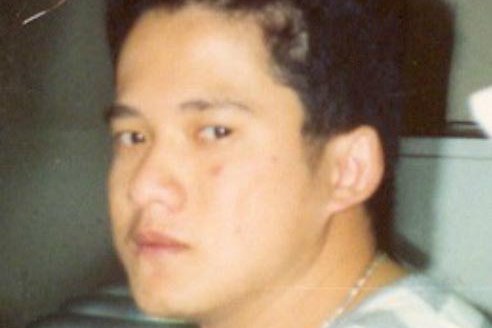
I read this “22nd of August 2003, a 33-year-old Wingfield man – likely Quyen Tu Au…” and I believe it is an error. Didn’t Au go missing and was presumed dead in 2000?
LikeLike
Yes you’re right that is an error. It meant to say An Man Tran. Mustn’t have picked it up on editing. I’ll fix that up now. Thank you for letting me know!
LikeLike